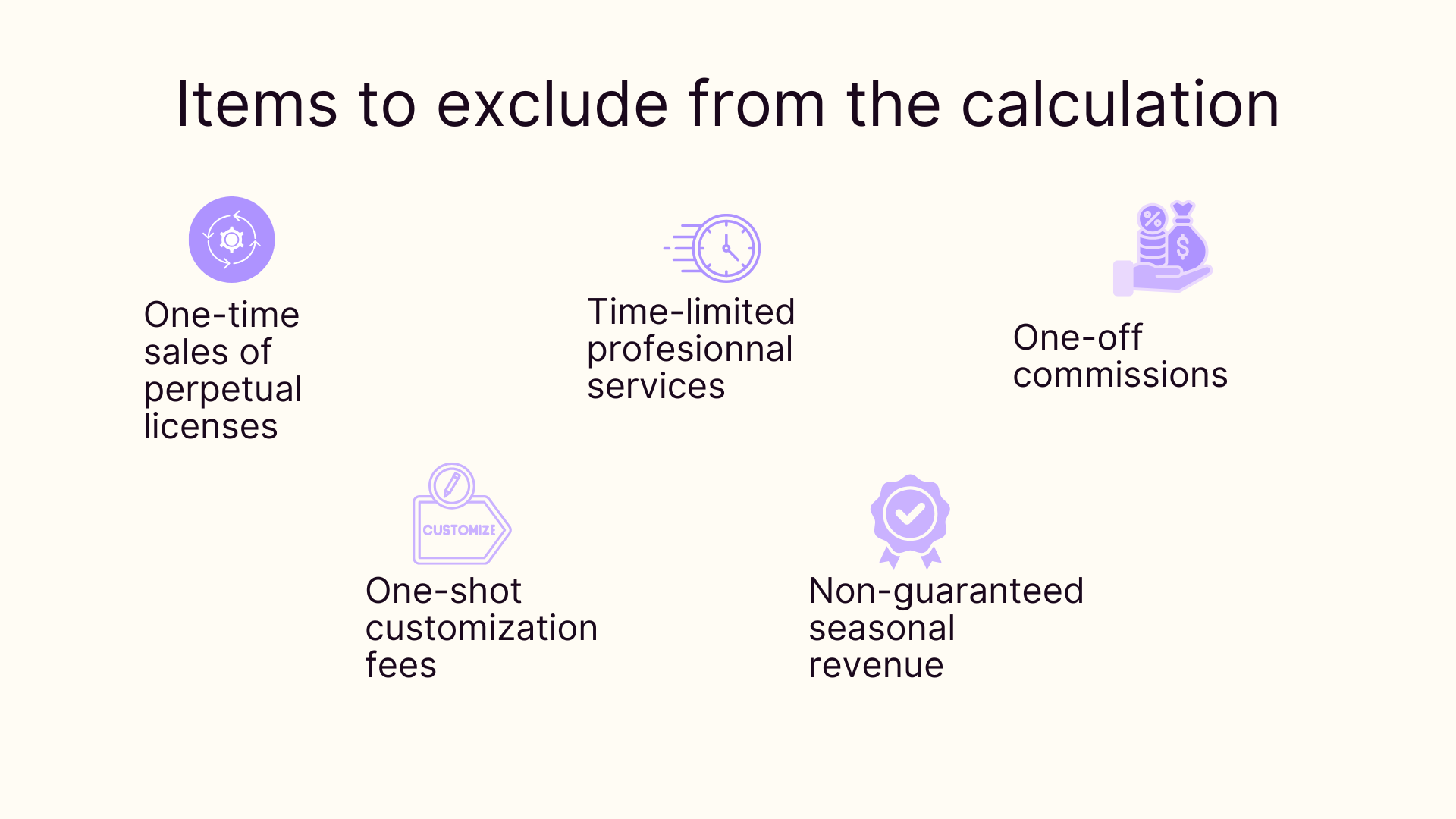ARR: Definition and Calculation for SaaS Companies
The success of a SaaS company depends on its ability to generate predictable, recurring revenue. Annual Recurring Revenue (ARR) precisely measures this performance by calculating the yearly recurring revenue from subscriptions. This strategic metric allows leaders to drive growth, optimize business decisions, and demonstrate the strength of their business model to investors. Discover how to master this essential indicator for your SaaS company.
- Definition & Strategic Importance: ARR is the annualized sum of recurring revenue from subscriptions. It reflects the financial stability and predictable growth capacity of a SaaS company.
- Calculation & Components: The basic formula is MRR x 12. It's crucial to only include recurring revenue (subscriptions, ongoing add-on modules) and exclude one-time fees or non-recurring services.
- Relationship with Other SaaS KPIs: ARR is closely tied to MRR (its monthly foundation), Net New ARR (which measures actual growth), and the customer retention rate, which directly influences its stability.
- Optimization for Sustainable Growth: Increasing ARR involves targeted acquisition strategies, reducing churn, and increasing existing customer value (upsell/cross-sell). Clear reporting is essential for tracking progress.
What is ARR and Why is it So Important?
ARR represents the annualized sum of recurring revenue generated by your subscriptions. This fundamental metric reflects your SaaS company's financial stability and its ability to sustain steady growth.
A startup with an ARR of $1 million demonstrates its capacity to generate predictable long-term revenue. This visibility reassures investors and facilitates strategic decision-making, especially for hiring or expanding into new markets.
ARR differs from one-time sales because it forms a solid revenue base that is less sensitive to economic fluctuations. For a B2B SaaS company, tracking its evolution helps anticipate its growth trajectory and adjust sales actions accordingly.
The Fundamental Components of ARR
Recurring Revenue to Include
An accurate ARR calculation requires identifying the recurring revenue streams that form the basis of your subscription model. Monthly or annual subscription fees for your SaaS solution are the main component.
Revenue from permanent add-on modules or premium features subscribed to on a long-term basis should also be included. A customer upgrading from a standard plan to a premium version also generates recurring revenue to be accounted for.
Don't forget to include revenue from cross-selling when customers adopt complementary services on an ongoing basis. Here, frameworks like CAP SONCAS or the 4C model can guide how you shape upsell arguments that actually resonate with client motivations. For example, a company that adds a billing module to its existing CRM.
Items to Exclude from the Calculation
A precise ARR calculation requires excluding certain non-recurring revenues. One-time setup fees, initial training, or consulting services should not be part of your ARR.
Temporary discounts offered during marketing campaigns also distort the picture. A well-trained BDR team or Account Manager should be aware of these nuances when forecasting ARR to avoid overestimating long-term revenue. A 30% discount for 3 months does not reflect the actual recurring revenue of your business model.

A reliable ARR focuses solely on the predictable and regular financial flows of your SaaS business.
The Difference Between ARR and Revenue
ARR is fundamentally different from traditional revenue due to its predictive nature. A SaaS company with $2 million in annual revenue might have an ARR of $2.5 million if it signed new contracts late in the year.
The revenue metric records all past transactions over a given period. In contrast, ARR projects future revenue based solely on active subscription commitments.
This distinction is particularly strategic for assessing the financial health of a SaaS company. Stable revenue can sometimes hide a decline in subscriptions, whereas growing ARR indicates real, long-term business momentum.
How to Calculate ARR Accurately
The Basic Formula for ARR Calculation
The standard formula to determine your ARR is expressed mathematically as: ARR = MRR x 12. For example, a SaaS company selling document management software for $500 per month with 50 active customers has an MRR of $25,000, resulting in an ARR of $300,000.
For a more detailed analysis, a second method exists: ARR = [(Monthly Revenue + New Subscriptions + Additional Revenue) - (Cancellations + Revenue Loss)] x 12. This approach incorporates fluctuations in your customer base.
A monthly dashboard helps track these metrics rigorously. The key is consistent tracking and standardized measurement methods.
.png)
Necessary Adjustments Based on Your Model
Real-world scenarios require you to adapt your ARR calculation to the specifics of your business model. A precise adjustment is especially necessary for seasonal variations in your subscriptions. A company selling tax reporting solutions will naturally see its revenue fluctuate with the accounting calendar.
Planned pricing changes also require special attention. Anticipate the impact of a price increase on your existing customer base by creating different ARR evolution scenarios.
For a clear view of your growth, integrate variations related to long-term sales discounts and loyalty programs. For instance, a 20% discount granted over three years permanently alters your recurring revenue projection.
Automated Tracking and Calculation Tools
Modern SaaS management platforms significantly simplify ARR tracking. These solutions automate the collection of subscription data over a given period and generate custom dashboards.
Specialized SaaS metrics software offers essential features: syncing with your billing system, instant calculation of key indicators, and alerts for significant changes in your churn rate.
Advanced analytics tools also include forecasting modules for the coming years. This data-driven approach facilitates your funding requests and refines your retention strategy through quick estimation of cross-sell opportunities.
The Relationship Between ARR and MRR
Converting MRR to ARR
Transforming MRR into ARR relies on a simple yet strategic calculation method. For a SaaS startup with $50,000 in monthly recurring revenue, the ARR reaches $600,000 after multiplying by twelve.
This annual projection allows for a quick assessment of growth potential over time. A sales manager can, for example, anticipate the impact of a 10% increase in MRR on their annual target.
Data reliability plays a central role in this conversion. A company in the HR software industry must consider its existing customer base and acquisition cost to obtain an accurate result that reflects its economic reality.
When to Prioritize ARR vs. MRR
The choice between ARR and MRR depends directly on your Software as a Service model. A startup offering monthly no-commitment subscriptions will prioritize MRR for precise short-term cash flow tracking.
Conversely, an established company selling annual B2B contracts will rely on ARR. This metric better reflects the stability of its client portfolio and facilitates discussions with investors.
Your company's maturity level also guides this choice. A young, rapidly acquiring startup will focus on MRR to adjust its sales strategy. A scale-up in a consolidation phase will use ARR to optimize its strategic planning over 12-24 months.
KPIs to Complement ARR
Net New ARR and Growth
Net New ARR measures the actual growth of your recurring revenue over a given period. This strategic metric combines three essential components: expansion from existing accounts, new contracts signed, and revenue loss from cancellations (churn).
A B2B software publisher with a $5 million ARR might aim for a 50% increase in Net New ARR to meet its development goals. This growth relies on a balanced mix: 60% from new deals and 40% from existing customer expansion.
Benchmarks for 2025 show that high-performing SaaS companies maintain an expansion-to-new-business ratio of around 40/60 to maximize their sustainable growth rate.
Retention Rate and Its Impact on ARR
A high retention rate directly transforms your ARR growth. Data from 2025 reveals that a 5% improvement in retention can increase profits by up to 95%.
The B2B market sets a high bar: top-performing SaaS companies maintain customer retention around 85%. This stability ensures a solid foundation for your ARR.
Recurring revenue is built on two pillars: retaining existing customers and progressively upselling them. A satisfied customer spends, on average, 33% more after 36 months of use, naturally strengthening your ARR base.
Forecasting and Projections Based on ARR
Reliable ARR projections are based on analyzing historical trends combined with leading indicators. A B2B startup can anticipate its trajectory by assessing the expansion potential of its current customer base and the opportunities in its target market.
The "bottom-up forecasting" method improves the accuracy of estimates. For example, a company with a $2M ARR from 100 customers can project growth to $3M by calculating a 25% upsell potential on existing accounts and the acquisition of 30 new similar customers.
A dynamic projection table that incorporates seasonal variations and B2B sales cycles helps refine these forecasts. The most methodical companies adjust their projections quarterly to maintain a realistic path toward their development goals.
Optimizing Your ARR for Sustainable Growth
Acquisition Strategies to Increase ARR
A successful acquisition strategy relies on precise prospect qualification. The most effective companies use a scoring matrix to assess the compatibility of leads with their SaaS solution.
Implementing a strategic partnership program multiplies your acquisition channels. Smart management of distribution channels ensures that each new revenue stream contributes sustainably to ARR. A network of qualified resellers can accelerate your penetration into new market segments.
Account-Based Marketing tactics have proven their effectiveness in B2B. One tech company doubled its ARR in six months by personalizing its sales approach for 50 strategic accounts. The key? Perfect coordination between marketing and sales, combined with content tailored to each target account's decision-making journey.
Reducing Churn and Maintaining ARR
Controlling churn requires anticipating warning signs. An early detection system can identify at-risk customers before they leave, based on signals like decreased usage, payment delays, or absence from training sessions.
Usage data analysis reveals that 80% of churn occurs within the first 90 days. A structured onboarding phase reduces this risk by accelerating the adoption of key features by your customers.
Segmenting your customer base by engagement level allows you to tailor your retention actions. B2B companies that personalize their support based on usage maturity see an average churn reduction of 25% over 12 months.
ARR Reporting Best Practices
An effective ARR dashboard presents your key indicators on a single page. Visualize your monthly progress, variations by customer segment, and expansion trends at a glance.
The frequency of updates determines your reporting's relevance. Update your numbers weekly to maintain a clear view of your trajectory. Document your calculation methods in a guide accessible to the entire team.
Reporting becomes more powerful with historical comparisons. Overlay your current results with past performance to identify growth drivers. For example, a monthly chart comparing ARR Y/Y quickly reveals your growth cycles.
Share a summary report with your sales teams. This transparency boosts their engagement and understanding of development goals.
Frequently asked questions
What is the simplest way to calculate ARR (Annual Recurring Revenue)?
By multiplying your MRR (Monthly Recurring Revenue) by 12. This gives you a projection of your recurring revenue on an annual basis.
Why is ARR a more relevant indicator than overall revenue for a SaaS company?
ARR focuses on the predictable, recurring revenue from subscriptions, offering a better view of sustainable growth than one-time revenue figures.
ARR: Definition and Calculation for SaaS Companies
Acquiring new subscribing customers, increasing the value of existing customers (through upsell or cross-sell), and reducing the customer churn rate.
Turn opportunities into wins
With Cuevr, close more and faster
Cuevr helps you organize your thoughts and maximize every detail to persuade prospects more effectively and accelerate closing.
Precise, impactful proposals aligned with your goals.
Smart Builder, AI scoring, detailed tracking, and actionable recommendations to guide every step from qualification to closing.
Accelerate your sales cycles, Reduce ghosting, Improve your close rate, Enhance the quality and impact of your proposals
.avif)


.avif)


